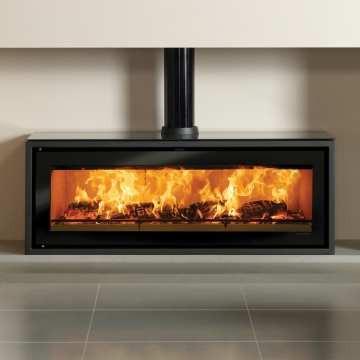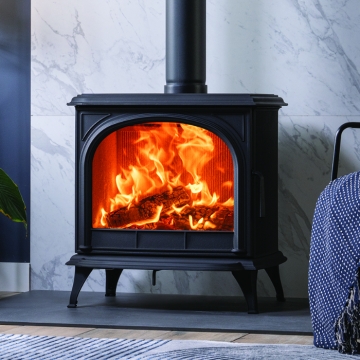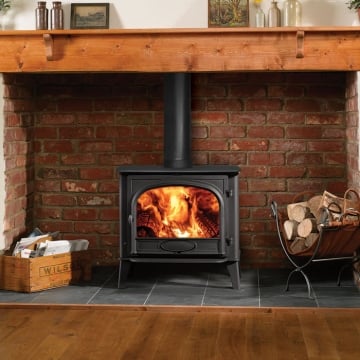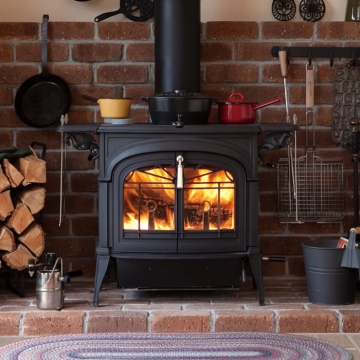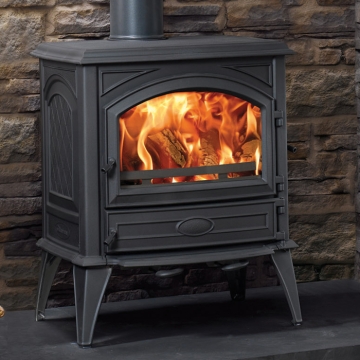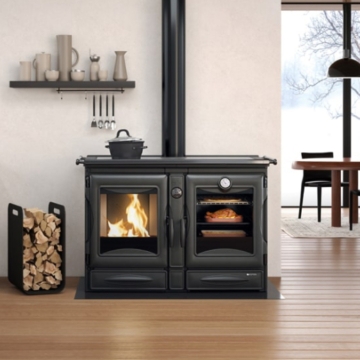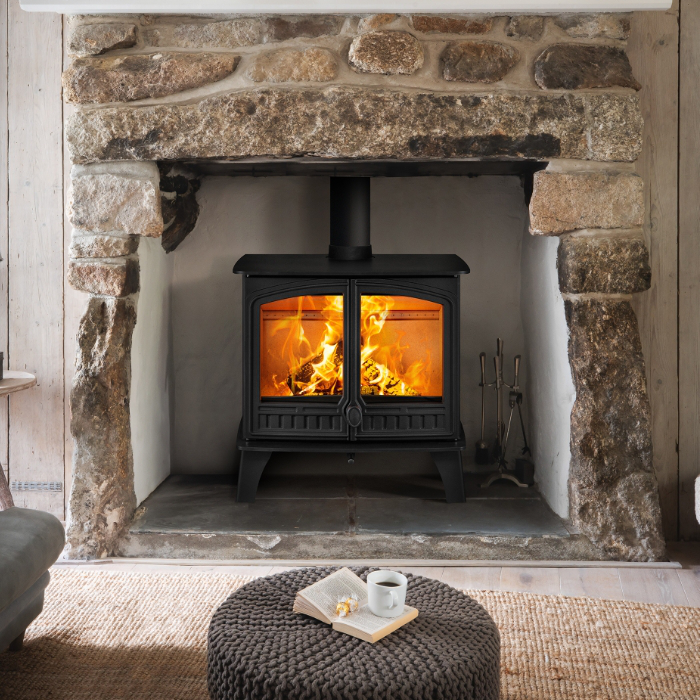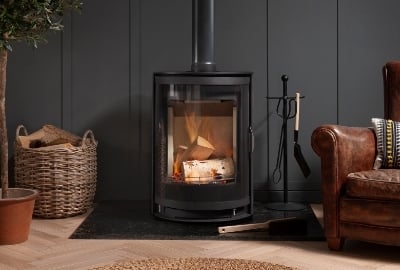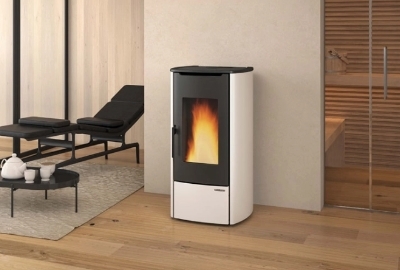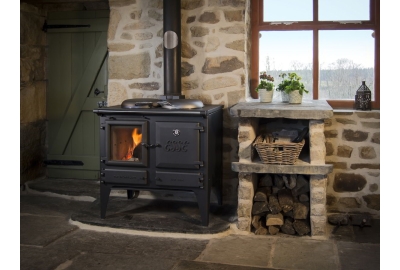When it comes to heating large spaces and open plan rooms, high-output log burners (also known as wood-burning stoves and wood burners) are an excellent choice. They combine aesthetic appeal with the ability to generate a significant heat output. In this edit, we’ll discuss the important factors you should consider before buying a powerful wood burner and we’ll provide you with some of our recommendations for high-output log burners suitable for large spaces.
Contents
Large log burner key considerations
Best high output log burners for big spaces
Do large wood burners need extra ventilation?
Can I heat two rooms with a wood burner?
Do you need more space around a large wood stove?
Large log burner key considerations
When looking for a high-output wood stove, particularly for heating a large space, there are several important factors to consider to ensure you choose a stove that is both efficient and suitable for your needs. Here are our top tips for choosing a large wood burning stove for your home, we’ve covered topics like the heat output you’ll need, ventilation requirements and fuel type, these are all the key components to choosing the perfect wood burner for your home.
- Heat output (kW) - One of the first considerations is to determine the heat output needed for your space. This is usually measured in kilowatts (kW) and a rough estimate is 1kW per 14 cubic meters (m³) of room volume. For larger, poorly insulated homes or higher-ceilinged rooms, you may need to increase the heat output to ensure the stove can easily heat the size of the space and avoid under-heating or overheating.
- Efficiency - Higher efficiency means more heat is generated from the fuel, resulting in less waste and lower fuel costs. You should look for wood burning stoves with an efficiency rating of 75% or higher. Modern stoves often achieve efficiencies above 80% so produce fewer emissions, making them more environmentally friendly.
- Type of fuel - Decide whether you want a stove that burns only wood or one that can burn other fuels like smokeless coal or peat. Multi-fuel stoves offer flexibility but have slightly different operating characteristics, smokeless coal doesn’t produce a large aesthetically pleasing flame as you see from a dedicated wood burning stove. You should also consider the cost and availability of seasoned wood in your area, as it burns more efficiently than unseasoned or green wood that you should not use on a wood burner.
- Size and design - A larger firebox allows for longer burn times and accommodates larger logs, reducing the need for frequent refuelling. You should ensure the stove fits comfortably in the intended space, both in terms of aesthetic proportions and physical installation and you should choose a design that complements your room’s decor, whether traditional or modern. The material a stove is built from can also be an important deciding factor, cast iron provides excellent heat retention and a classic look but takes longer to heat up. A stove made from steel can heat up quickly and often has a more modern appearance but may cool down faster. Some stoves use both materials to balance heat retention and quick warmth
- Environmental compliance - You should look out for a newer Ecodesign burner that complies with the European directive on air pollution and particulate emissions. These stoves are engineered to reduce emissions of Particulate Matter (PM), Organic Gaseous Compounds (OGC), Carbon Monoxide (CO) and Nitrogen Oxides (NOx) by increasing the temperature at the top of the wood burner firebox. Increased temperature reignites the combustion particles and reduces emissions before they leave the stove. DEFRA-Approved stoves can be used in smoke control areas and ensure that the stove can operate legally in these areas by meeting specific emission standards.
- Ventilation and chimney - High-output stoves require sufficient air supply so you need to consider the ventilation within your room and whether additional vents might be necessary. Lots of modern stoves are available to purchase with direct air kits so you can feed additional air supply directly into the appliance rather than into the room. You also need to ensure that your chimney or flue is suitable for the stove you choose, you may need a flue liner or a new twin wall chimney system to safely install a log burner.
- Additional features - Some of the best stoves offer excellent efficiency and stylish looks but you should keep an eye out for other features that will make starting your stove and maintaining it much easier. An airwash system helps to keep the stove glass clean by directing a flow of hot air over it, ensuring a clear view of the fire. This is particularly useful for maintaining aesthetics and reducing the need for frequent cleaning. Many high-output stoves feature secondary combustion, where unburnt gases are reignited, leading to more efficient fuel usage and cleaner emissions. Easy to adjust controls help to regulate the burn rate and heat output more precisely, providing better control over room temperature. Finally, a stove with an adjustable baffle can assist with lighting your fire and maintaining the heat output.
By considering these factors, you can choose a high-output stove that is well-suited to your space, efficient, and meets your heating needs while complementing your home’s style. A high output log burner is a solid choice if you need to heat a large space and are prepared for the associated fuel costs and maintenance. However, if your space is smaller or you have good insulation, a lower output model might be more appropriate and more cost-effective.
Best high output log burners for big spaces
Here we’ve put together large wood burning stoves that offer strong performance for heating large spaces, with variations in fuel type, efficiency, and design to match your specific needs. We’ve picked wood burners made by some of the best, most sought after brands in the market like Stovax, Burley & Parkray that offer efficient heating with a long burn time too.
Do large wood burners need extra ventilation?
If you have a large room where you’re looking to install a wood burner or multi-fuel stove then it is important to consider what your log burner ventilation requirements will be. If you require a heat output that exceeds 5kW then you’ll need either a direct air supply into the appliance or ventilation within the room that will increase depending on the kW output of the log burner. The higher the kW output of the wood burning stove, the more air is needed for the appliance to burn properly and the size of the air vent is dependent on the kW output of the heater. In properties that were built prior to 2008 that are not as well insulated and have not been renovated, the first 5kW of a stove does not require an air vent or air brick, but every kW over 5kW requires an additional 550mm2 of ventilation.
Can I heat two rooms with a wood burner?
There are a couple of different ways for you to heat multiple rooms with a log burner but which one you choose will depend on the requirements of your home heating needs. By choosing a high-output stove or even a double sided stove, you can ensure a heater that is well-suited to your space and with plenty of stylish options available you can easily complement the interior of your home.
- Large output stoves - If you have a large open plan space then a wood burner that exceeds 5kW can be the ideal solution. You’ll find wood burners that produce over 12kW of heat in our range that can easily warm large areas. You’ll find heat from a wood burner can disperse into other areas of your home by keeping doors open so if you like the idea of a cosy home you should consider a wood burner with a large heat output.
- Double sided stoves - If you love the idea of luxury and comfort then why have it in more than one room in your home? A double-sided fireplace can be a unique addition not only because they look amazing but they also add warmth to two separate spaces. These types of fireplaces are ideal for adjoining rooms with a central chimney or flue and are becoming increasingly popular in new build properties.
- Boiler & central heating stoves - These wood burners feature a metal cavity that is filled with water. The heat that is produced from burning wood in your boiler stove heats the water, which can then be used to heat hot water and radiators in other rooms within your home.
Do you need more space around a large wood stove?
Starting from the ground up, a wood burner should sit on a non-combustible hearth which could be stone like granite or slate or you could choose something more contemporary like toughened glass. In terms of the distance required between the stove and surrounding walls, the minimum requirement to the sides is usually 150mm whilst behind the stove is often between 50-150mm.
The distance your wood burner must be from combustible materials will vary from stove to stove, but there will always be a minimum requirement specified in the manufacturer and their installation guide. Depending on the heat output of the stove you choose the clearance required around it to combustible furnishings can be anywhere between 300-800mm but again this will be listed within the manufacturer’s specifications and manual.


